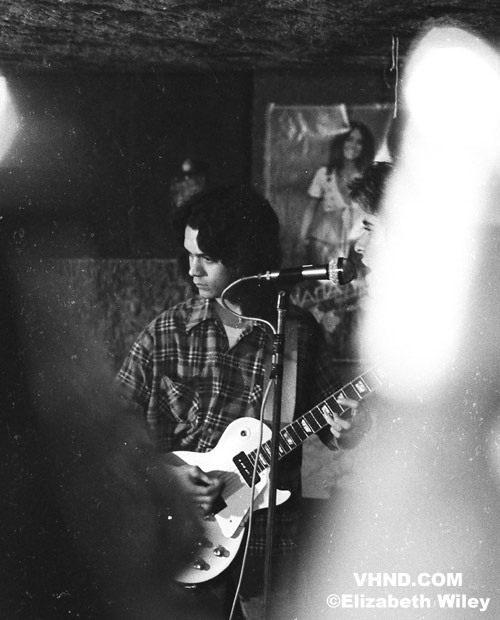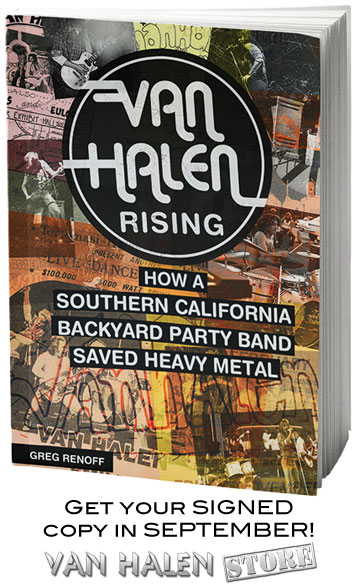 This never before published photo of a 19-year-old Edward Van Halen was was taken by Elizabeth Wiley in her garage on Maiden Lane in Altadena around the spring of 1974. This is Van Halen pre-Michael Anthony. Mark Stone was still the bassist. VH was now a quartet, as their keyboard player had just left band.
This never before published photo of a 19-year-old Edward Van Halen was was taken by Elizabeth Wiley in her garage on Maiden Lane in Altadena around the spring of 1974. This is Van Halen pre-Michael Anthony. Mark Stone was still the bassist. VH was now a quartet, as their keyboard player had just left band.
This photo captures the young band rehearsing, as they did four hours a day nearly every day. Ed’s playing his Les Paul Goldtop that his father Jan bought for him. A glimpse of David Lee Roth can be seen just behind whatever is obscuring part of the photo.
This is real, legit GARAGE BAND-era Van Halen!
Want to see many more photos from this little-known era of Van Halen? Be sure to order your copy of Van Halen Rising: How a Southern California Backyard Party Band Saved Heavy Metal. Oh, and more about Van Halen’s unknown keyboard player will be revealed in the book, as well!
If you would like to get even more excited about the book, this manifesto below, written by the book’s author, Greg Renoff, should definitely do it.
Back in 2009, I had a two-part revelation about my favorite band, Van Halen, and its place in the pantheon of rock’s greatest acts.
The first part involved Van Halen’s history. When I started to research the group’s pre-fame years in Los Angeles, I discovered that very little specific (much less accurate) information about those years had been nailed down. Here’s just a sampling of the aspects of Van Halen history that remained shrouded in legend:
- When did the brothers’ form their pre-David Lee Roth power trio? Which songs — other than those by Cream — did this band (first called Genesis, later renamed Mammoth) play? When did this band become “Van Halen”?
- What did Roth’s band, Red Ball Jet, look and sound like?
- When and how did David Lee Roth team up with the Van Halen brothers?
- What are the facts concerning Van Halen’s backyard party exploits? Were they really as wild as legend suggests?
- What actually happened when Gene Simmons tried to get Van Halen a record deal? Is it true that he tried to poach Eddie for KISS in 1977?
- How did Van Halen end up on Warner Bros. Records? Was it all just a matter of label executives wandering into Hollywood’s Starwood Club one night “because it was raining outside,” as Roth claimed?
- Did Van Halen, as an opening act, really steal the show from well-established bands like Journey and Black Sabbath in 1978?
Once I started getting satisfactory answers to these questions from my interviews with Pasadena natives and with Van Halen luminaries like Michael Anthony, Ted Templeman, Donn Landee, Pete Angelus and Marshall Berle, the second revelation hit me:
- If I wanted to learn the details of how The Detours became the Who, an explosively powerful band that wrote some of the most timeless songs in rock history, I could read that story in any number of books.
- If I wanted to learn the details of how the New Yardbirds became Led Zeppelin, a group that stormed the globe and released some of the best albums in rock history, I could read that story in any number of books.
- But if I wanted to learn the details of how Mammoth became Van Halen, a band that recorded one of the most successful debuts in rock history and wowed stadium crowds in 1978, I couldn’t read that story.
This was a major problem. Not just for me, but for Van Halen fans across the globe, because this story needed to be told.
Somebody, I thought, needed to write a comprehensive, carefully documented, and compulsively readable book about this lost period in Van Halen history.
That person, I decided, should be me.
 You see, I came to believe the reason why rock fans didn’t mention the original lineup of Van Halen in the same breath as Led Zeppelin, for instance, is that no one really knew how hard Van Halen had worked to make it and all the adventures the band members had experienced before their 1978 breakout.
You see, I came to believe the reason why rock fans didn’t mention the original lineup of Van Halen in the same breath as Led Zeppelin, for instance, is that no one really knew how hard Van Halen had worked to make it and all the adventures the band members had experienced before their 1978 breakout.
Consider the following:
- The Van Halen brothers started playing backyard parties about a year after Woodstock. They were still playing backyard parties in 1976.
- The band started playing dive bars sometime around 1973. They were still playing these dumps when 1977 dawned.
- Record companies rejected Van Halen as early as 1974. In fact, Gene Simmons, then one of the most powerful musicians in America, couldn’t get the band a record deal in late 1976.
Despite all these obstacles and setbacks, the quartet refused to quit.
They gigged everywhere in Los Angeles, playing in front of anyone who’d listen for next to no money, for years. In fact, they played live, during one stretch, for twenty-three nights in a row.
They wrote and demoed song after song, even though label executives at the time thought little of these original compositions.
They heard time and time again, from everyone from KISS’s manager Bill Aucoin to A&M Records’ head Herb Alpert, that Van Halen wasn’t a commercially viable band.
Even after they got their Warner Bros. deal in 1977, many in the industry expected that this heavy metal band’s debut LP would make zero impact on the Billboard charts, in light of the fact that disco and soft rock ruled the airwaves during those years.
Then something funny happened in the spring and summer of 1978.
Van Halen, an album heavier than anything else at the top of the charts, started selling like crazy. Van Halen went from a third billed band on a theater tour to a group that sent stadium crowds into delirium. Van Halen became superstars.
Once that happened, critics and cranks thought they knew the band’s story. An overnight sensation, they surmised.
Bullshit.
Roth’s daddy had money, so that’s why the band made it, some whispered.
Bullshit.
Here’s the truth, which will be fleshed out in Van Halen Rising when it’s released via ECW Press later this year. It was during the years when almost no one outside of Los Angeles had ever heard of Van Halen that this band became talented enough to record one of the greatest debut albums in history and tight enough to blow the biggest bands in the world off the stage.
Van Halen, it turns out, became The Mighty Van Halen in the biker bars, ballrooms, and dance clubs of Los Angeles. That’s when and where the magic happened for this band.
And so to this day, even the biggest Van Halen fans don’t know the details of rock’s biggest success story: How Van Halen went from a backyard party band to a band good enough to keep heavy metal alive as it faced extinction at the hands of punk, disco, and soft rock.
Van Halen Rising will provide these missing chapters in Van Halen history, ones that will conclusively demonstrate the legendary greatness of this band.
So next time some loudmouth tells you that Van Halen can’t match up with the Who and Led Zeppelin, tell this misinformed person that they don’t know the full Van Halen story.
Yet.
 Get VAN HALEN RISING! It’s coming soon, so ORDER NOW. Your choice of a signed or unsigned copy will ship from VanHalenStore.com in mid-September.
Get VAN HALEN RISING! It’s coming soon, so ORDER NOW. Your choice of a signed or unsigned copy will ship from VanHalenStore.com in mid-September.
Follow VAN HALEN RISING! The VHND highly recommend “liking” Van Halen Rising’s excellent Facebook page and also following the book on Twitter. Author Greg Renoff has been doing a great job on social media.